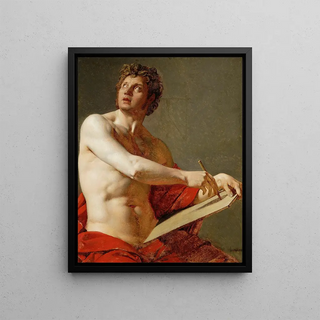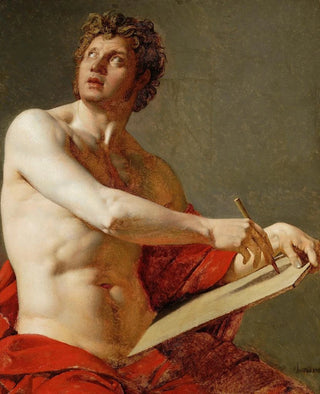Art print | Academic study of a nude man - Jean-Auguste-Dominique Ingres


View from behind

Frame (optional)
The artwork "Academic Study of a Nude Man" by Jean Auguste Dominique Ingres is much more than a simple representation of the human body. It embodies an aesthetic and philosophical quest that marked the 19th century. Ingres, master of neoclassicism, manages to capture the ideal beauty and perfection of human proportions, while revealing the complexity of human nature. This study, often considered a masterpiece, invites the viewer to reflect on notions of beauty, truth, and art. Through this art print, we delve into the universe of an artist whose influence endures and who continues to fascinate art enthusiasts.
Style and uniqueness of the work
The originality of Ingres's work lies in its ability to combine academic rigor with artistic sensitivity. His drawing technique, precise and refined, highlights the finesse of contours and the delicacy of shadows, creating an atmosphere that is both austere and poetic. The nude man, depicted in a classical pose, evokes ancient sculptures while standing out through an expressiveness unique to Ingres. The fluidity of lines and the luminosity of forms testify to an unparalleled mastery of the human body, where every muscle and curve is sublimated. This study, far from being a simple academic exercise, becomes a true manifesto of timeless beauty, transcending eras and styles.
The artist and his influence
Jean Auguste Dominique Ingres, born in 1780, is an emblematic figure of neoclassicism, but also a precursor of romanticism. His career, marked by successes and controversies, testifies to a bold artistic vision. Ingres knew how to establish himself with his unique style, blending classical rigor and emotion, which allowed him to influence many artists, both contemporaries and successors. His approach to the human body, notably through studies like this one, redefined the standards of artistic representation. Many 20th-century artists, such as Picasso and Matisse, drew from his legacy to develop their own visual language. Thus, Ingres does not merely appear in the

Matte finish

View from behind

Frame (optional)
The artwork "Academic Study of a Nude Man" by Jean Auguste Dominique Ingres is much more than a simple representation of the human body. It embodies an aesthetic and philosophical quest that marked the 19th century. Ingres, master of neoclassicism, manages to capture the ideal beauty and perfection of human proportions, while revealing the complexity of human nature. This study, often considered a masterpiece, invites the viewer to reflect on notions of beauty, truth, and art. Through this art print, we delve into the universe of an artist whose influence endures and who continues to fascinate art enthusiasts.
Style and uniqueness of the work
The originality of Ingres's work lies in its ability to combine academic rigor with artistic sensitivity. His drawing technique, precise and refined, highlights the finesse of contours and the delicacy of shadows, creating an atmosphere that is both austere and poetic. The nude man, depicted in a classical pose, evokes ancient sculptures while standing out through an expressiveness unique to Ingres. The fluidity of lines and the luminosity of forms testify to an unparalleled mastery of the human body, where every muscle and curve is sublimated. This study, far from being a simple academic exercise, becomes a true manifesto of timeless beauty, transcending eras and styles.
The artist and his influence
Jean Auguste Dominique Ingres, born in 1780, is an emblematic figure of neoclassicism, but also a precursor of romanticism. His career, marked by successes and controversies, testifies to a bold artistic vision. Ingres knew how to establish himself with his unique style, blending classical rigor and emotion, which allowed him to influence many artists, both contemporaries and successors. His approach to the human body, notably through studies like this one, redefined the standards of artistic representation. Many 20th-century artists, such as Picasso and Matisse, drew from his legacy to develop their own visual language. Thus, Ingres does not merely appear in the






